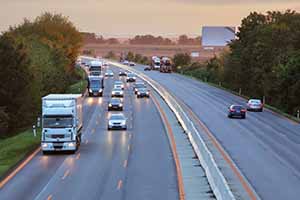Courtesy is an essential component of driving in Kentucky and the rest of the country. When driving on a busy highway or a road with multiple lanes, it’s common sense to go in the right-hand lane. When two vehicles get to a four-way stop at once, the car on the right should have the right of way. The rule of safety and courtesy is not to go too close or tailgate. Tailgating is both annoying and dangerous and can lead to deadly crashes.
What’s In This Post:
- How dangerous is it to follow another vehicle too closely?
- The Two-Second Rule
- Why Is a Safe Following Distance Important?
- What is a Safe Distance Between Cars on a Highway?
- Defensive Driving Techniques Can Keep You Safe on the Road
- Keep Distance Between Yourself And Other Vehicles
How Dangerous Is It To Follow Another Vehicle Too Closely?
Tailgating can result in catastrophic accidents, leading to severe injuries and death. Most rear-end accidents in Kentucky and the US are caused by tailgating motorists who leave little room for the vehicle in front. Drivers who tailgate can be legally prosecuted and held accountable for any accidents resulting from the collision. They can be made to pay for the damages and medical expenses.
In most cases, drivers tailgate because they are impatient to get to their destination. Other times it’s just a case of deliberate miscalculation. If the driver in front stops or slows down suddenly, the tailgating driver may not have enough time to follow suit, and it can result in a catastrophic accident. They could be driving too fast, and a slight speed reduction can be fatal.
Furthermore, tailgating can intimidate the driver in front, causing them stress and negatively impacting their concentration. Tailgating is also a sign of space invasion, one of the major catalysts for road rage. The driver in front may deliberately slam on the brakes in a fit of rage. Our Kentucky personal injury lawyers have seen this scenario time and time again.
The Two-Second Rule
The two-second rule refers to the practice adopted by most states to maintain a safe following distance between vehicles on the road. It’s the easiest way to know if you’re following the car in front too closely or if you’re maintaining the minimum safest distance.
The two-second rule provides the required minimum distance to allow you to react and take the necessary action in case something happens ahead. Two seconds is the minimum required time, but three or more seconds are better. Some states have the three-second rule, but in Kentucky, the minimum safe distance should be two seconds.
In case of bad weather such as rain and you’re following a motorbike, you should maintain at least four-second distance. When it rains, it makes the road slippery, and extra space is necessary should your vehicle start to skid. You also need to maintain a longer distance between motorcycles because, unlike other larger vehicles, they can stop quickly, and you need the time to react if something happens in front of you.
Why Is a Safe Following Distance Important?

Typically, most drivers tailgate to stay ahead as much as possible to lock out overlapping drivers who may attempt to cut them in. While this is entirely logical, it’s a dangerous habit contributing to thousands of crashes annually. The problem is further compounded since different drivers have different opinions on what constitutes a safe distance. A distance that may seem perfectly safe to one driver may spell danger to the other. For a driver to stop in time, they need to intercept potential risks and react immediately.
When drivers maintain the proper distance, they can have better visibility, which helps them anticipate and react in time should something happen ahead.
When a driver follows too close, they have limited focus and view of the road ahead. Since they have limited space and time, the tailgating driver understands that should the vehicle in front stop suddenly, a rear-end crash cannot be avoided. This awareness and concern cause the driver at the back to focus more on the car in front than on the road ahead.
And when a driver’s attention is entirely focused on the car in front, they miss all other important things going on around them. This lack of concentration on the road is another catalyst for road collisions.
What Is a Safe Distance Between Cars on a Highway?
As mentioned above, safe distance constitutes at least two seconds between two vehicles following each other. In other states, this safe distance can be three seconds or more. But in Kentucky, two seconds is the required minimum. Other examples of safe driving distances include:
- Fifty feet for farm tractors with a speed of 25 mph;
- Seventy feet for Snow Plow with a rate of 55 mph;
- 243 feet for cars;
- 300 feet for semi-trucks;
- 500 feet for emergency vehicles;
Defensive Driving Techniques Can Keep You Safe On The Road
Naturally, you cannot control most things that happen on the road. For example, the actions of other road users, weather conditions, and poor road conditions are beyond your control. However, you can make your driving experience safer by employing some defensive driving techniques, such as:
- Concentrating on the task ahead: As the driver, resist every distraction you encounter on the road. Avoid using the phone while driving. Whether it’s your spouse who’s arguing, kids fighting in the backseat, or defective air conditioning, your focus should be on the road and the car ahead of you.
- Expecting other motorists to mess up: You’re the only same person on the road. Always remember that.
- Avoid speeding: According to a US Census conducted in 2009, 33,808 fatalities were caused by over-speeding. The higher your speed, the longer you’ll stop or slow down, and the more catastrophic the impact. To stay safe, flow with the traffic and avoid speeding.
- Buckle up always: Most car accidents could be avoided if only drivers and their car occupants learned to buckle up always. According to the National Safety Council, seat belts reduce the risk of injury in an accident by 50 percent. Between 2004 and 2008, seat belts saved over 75,000 lives.
- Learn to yield: If you’re uncertain about who has the right of way, it’s advisable to yield rather than avoid an awful situation. It’s always better to lose a bit of your time than be involved in a crash.
- Acknowledge the red light: One major cause of intersection collision is ignoring the red light. Whether it’s the glare of the sun, lack of concentration, or a hurry to get to your destination, never run the red light. Always slow down when approaching an intersection.
Keep Distance Between Yourself And Other Vehicles
As we have seen, tailgating is a common practice on most American roads and a serious offense in Kentucky. Tailgating drivers who cause rear-end collisions can be held liable for those crashes and can end up paying for damages to the victims. According to NHTSA, 1/3 of all traffic accidents are due to tailgating, and they could be avoided by maintaining a proper safe distance. To be on the safe side, allow at least two seconds between you and the driver in front when driving in good weather and more seconds when driving in foul weather.
Flora Templeton Stuart Accident Injury Lawyers has been representing car accident victims for over 46 years. Contact us for more information.
